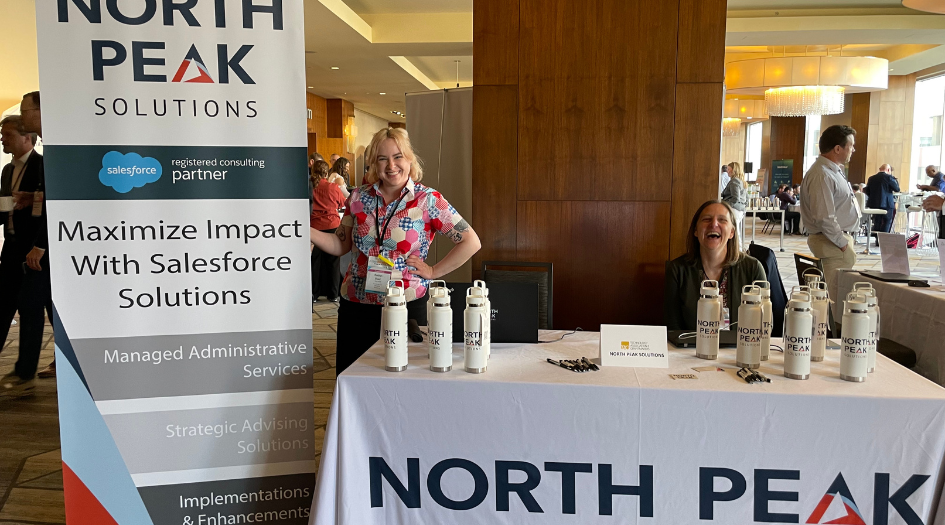
How to Ensure a Successful Salesforce Implementation
Implementing Salesforce—especially for nonprofits and foundations—isn’t just about configuring the platform to meet organizational needs. The goal is to put in place a system that empowers teams, streamlines operations, and supports long-term impact. To achieve this, a successful implementation requires clear communication, collaboration between all stakeholders, and an understanding of the roles and expectations for all involved.
At North Peak, we’ve guided hundreds of nonprofits and foundations through complex Salesforce implementations. We’ve seen what works, what doesn’t, and how to pivot when things aren’t going as planned. Here’s what we’ve learned about making Salesforce implementations successful—for both the consultant and the client.
The Role of the Consultant in a Salesforce Implementation
To ensure a successful Salesforce implementation it’s essential to get clear on roles, expectations, and outcomes—right from the start. Roles and expertise within an organization may shift during the implementation, so don’t be afraid to periodically revisit this conversation to ensure everyone continues to be on the same page.
From our perspective, the consultant’s role in a Salesforce implementation is first and foremost to guide the client from discovery and configuration through to training and post-launch support. Beyond that, a good consultant is a partner to the organization they’re working with. They bring technical expertise and offer strategic advice, but they also care about helping their clients meet and exceed their mission-critical goals.
A good consultant isn’t trying to sell you on a specific product or platform, rather their aim is to make sure clients are equipped with the best technology solution to meet and exceed their mission-critical goals.
The Role of the Client in a Salesforce Implementation
Even the best Salesforce implementation partner can’t make a project successful without an engaged and motivated client team. In fact, client engagement is essential for the success of an implementation. At North Peak, client engagement includes:
- Active Participation in User Stories. User stories map out in detail how clients will interact with the system. They cover roles, actions and desired outcomes within the system. When reviewing user stories isn’t prioritized, gaps show up later.
- Be Prepared for Meetings. It seems like a no-brainer, but clients need to attend scheduled meetings. Come with questions and review materials ahead of time. This isn’t just a courtesy—it’s essential to keep the project on track.
- Actively Engage in Training. Eventually you (the client) will need to own and manage the new system. Time and again we’ve seen that the most successful clients are the ones asking questions, completing Trailheads, and following up with questions and clarifications.
- Own the Data Migration Piece. Unless otherwise specified in the contract, clients are responsible for ensuring their data is clean and ready. Typically, clients provide raw data, meet with us to discuss format and structure, and then work to align it with Salesforce requirements. A clean migration is an essential component for a smooth launch of the new system.
What Makes an Implementation Successful?
From our perspective as a consultant, a successful implementation includes:
- User stories that are defined at the beginning and are configured, tested, and accepted by the client.
- The client is confident using the system and actively engaged during training sessions.
- Post-launch, the client feels empowered to manage the database without daily support and/or they utilize our Managed Services to help them during the transition of hiring and training an in-house admin.
From the client’s point of view, success means:
- Their original needs are met, and the system functions as intended.
- Staff are comfortable using Salesforce and onboarding others, or they have contracted for Managed Services to help them with additional staff training and admin support.
- They can troubleshoot issues—or know who to call on for additional support.
Transitioning CRM Ownership to the Client
When it’s time to transition CRM ownership to the client, a smooth handoff is crucial. Each situation is unique depending on the project and clients needs, but handoffs all include:
- Training Plan & Documentation: Every training comes with an agenda, notes, and a recording. This helps clients when they need to revisit materials later, or train new staff on the system. Trailhead is a fantastic (and free!) way to gain practical knowledge.
- Detailed Guides: We often create step-by-step flow documentation, especially for more complex automations or common troubleshooting scenarios. This is a great resource for clients again when they are training new staff or troubleshooting issues on their own.
- Custom Support: Some clients need extra support post-launch, which we tailor based on their team size and technical comfort.
A Salesforce implementation isn’t just about getting a system up and running. It’s about building long-term capacity and a data-driven culture inside your organization. When roles and expectations are clearly defined and engagement is consistent, your team will be set up for long-term success with the new system.
About North Peak
North Peak provides Salesforce-based services for nonprofits, foundations and the affordable housing sector who want to utilize the power of high-functioning CRM and GMS platforms. We achieve this through a holistic set of services, tailored to the needs of our clients.
Blog: Project Managers are Key to a Successful Salesforce Implementation
When it comes to big initiatives like a Salesforce implementation, the project manager is the glue that helps hold the project together.
Schedule a Free Consultation
If you’re considering implementing Salesforce or need help with Managed Administrative Services, or simply have questions about how to transform your organization’s data practices, we’d love to talk! Contact us for a free 30 minute call.



